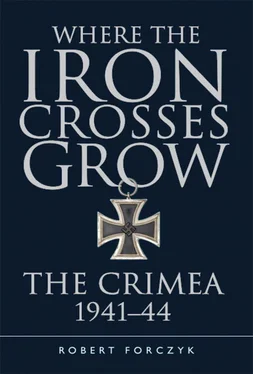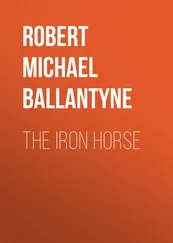The situation only grew worse for the other convoys approaching the Chersonese Peninsula on the night of May 10/11. Once the sun came up the VVS-ChF appeared in force, and Il-2s attacked and sank the Romanian minelayer Romania (3,152 GRT) and the freighter Danubius (1,489 GRT), while the German freighter Helga ran aground and was later destroyed. Lieutenant Commander Titus Samson’s destroyer Regele Ferdinand attempted to protect the freighters with its 40mm Bofors antiaircraft guns, but it was itself targeted by numerous air attacks. One bomb struck the hull and killed 11 crewmembers, but did not explode. A Soviet 152mm howitzer battery also engaged the Regele Ferdinand , and Samson returned fire with his 120mm guns. By 1030hrs Samson was forced to quit the area due to damage and running low on antiaircraft ammunition – Axis ships could no longer survive in daylight hours in Crimean waters. The Romanians dispatched more merchant ships from Constanta and the evacuation continued on the night of May 11/12. Soviet artillery fired illumination rounds to light up the beach areas, which were then pounded with high explosives. The Romanian destroyer Regina Maria escorted the convoys back from the Chersonese on the morning of May 12, but the merchantman Durostor was attacked by 12 Pe-2 bombers and sunk. German and Romanian soldiers on the decks of the merchantmen were exposed to strafing, bombing, and artillery fire, which caused numerous casualties.
The German divisions held the narrow neck of the Chersonese Peninsula as long as they could, but were under constant attack. Sturmgeschütz-Abteilung 191 still had eight operational StuG III assault guns that made it to the Chersonese, but they were the target of constant air and artillery attacks. Meanwhile, the Soviets were already rejoicing in the liberation of Sevastopol and Marshal Aleksandr Vasilevsky, who had coordinated operations between Tolbukhin’s 4th Ukrainian Front and the Coastal Army, was eager to tour the shattered city. However, Sevastopol was still littered with unexploded ordnance, and as Vasilevsky’s staff car moved down the road across Mekenzievy Mountain on May 10 he had the ill luck of driving over a German mine. [14] Aleksandr M. Vasilevsky, Dyelo vsyey zhizhi [ The Point of All Life ] (Moscow: Politizdat, 1978), p. 395.
Marshal Vasilvesky was wounded and evacuated to Moscow for military treatment – not an auspicious start to the liberation. However, the German troops isolated on the Chersonese Peninsula were unaware that they had succeeded in wounding a Soviet marshal and were instead focused on their fight to survive until they could be evacuated.
The Axis defense began to crumble late on May 11, as Tolbukhin’s forces launched attack after attack. Some Romanian mountain troops were still in the fight, but the bulk of the 3rd Mountain Division had already been evacuated. By 2300hrs, all units were ordered to retreat to pre-designated embarkation points. However, this signal resulted in a disorderly race for the boats, and order and discipline began to collapse even in German units. The Soviet 19th Tank Corps was hard on the heels of the retreating Axis units, followed by the 383rd Rifle Division and 32nd Guards Rifle Division. Generalmajor Alfred Reinhardt, leading the remnants of his 98. Infanterie-Division, managed to load all his troops in an ordered manner by 0300hrs on May 12 and get away, but other units were less fortunate. In any evacuation operation, troops fear being forgotten or left behind. At this critical moment, Konteradmiral Schulz, who was operating from an S-Boat offshore, suffered communications problems that interfered with his ability to direct shipping to the right embarkation point at the right time. Insufficient transports arrived to pick up either the 50. or 336. Infanterie-Divisionen, and none at all for the 111. Infanterie-Division. Only about 2,800 troops from the 50. Infanterie-Division, including Hauptmann Walter Salzmann, commander of Füsilier-Bataillon 50, managed to escape. A 2,756-man Romanian detachment, with five mountain battalions from the 1st and 2nd Mountain Divisions, was also left behind. Some transports returned empty to Constanta, having failed to find the correct embarkation beaches. The remaining troops were left with their backs to the sea, often in tactically indefensible positions. Some officers committed suicide rather than face capture, while others tried to disguise themselves as enlisted men. On the morning of May 12 the Soviets rushed into the Chersonese Peninsula with tanks and infantry, crushing resistance nests. By 0945hrs, a large concentration of Axis troops was surrounded at the airstrip by the 19th Tank Corps. Flushed with victory, many Soviet troops shot surrendering German troops out of hand. Thousands of Germans and Romanian troops were captured, but the exact numbers are uncertain.
Generalmajor Erich Grüner, who had distinguished himself as a regimental commander during the second battle of Kharkov in May 1942, led the final stand of the abandoned 111. Infanterie-Division. When Soviet T-34s began overrunning his positions at the water’s edge, he stood up and died on his feet, with his Ritterkreuz at his throat. Many of the rest of his troops surrendered. A group from the 50. Infanterie-Division managed to hold out for hours, until they were overwhelmed by Soviet OT-34 flamethrower tanks and heavy artillery. Generalleutnant Hermann Böhme’s 73. Infanterie-Division managed to hold its positions throughout the day, expecting that more rescue ships would appear at nightfall. Lieutenant Commander Anton Foca’s Amiral Murgescu , a modern 812-ton minelayer armed with 40mm and 20mm antiaircraft guns, was the last Romanian warship to arrive off the Chersonese, and it was able to take off about 1,000 troops, including General der Artillerie Walter Hartmann, the commander of the XXXXIX Gebirgs-Korps. Several other ships loitered in the waters off the Chersonese in the early morning hours of May 13, dodging artillery and air attacks, and collecting troops who paddled out to them in life rafts or swam. At 0330hrs, Konteradmiral Otto Schulz, aboard an S-Boat from the 1. Schnellbootsflottille, decided to terminate further rescue efforts and head out to sea before the sun rose. Generalleutnant Böhme remained in his command post to the end, until it was overrun by Soviet troops on the morning of May 13. He was captured, but would eventually return to Germany many years later.
Between May 10 and May 13 the Kriegsmarine and Royal Romanian Navy evacuated another 47,825 personnel from the Crimea, including 28,992 German and 15,078 Romanians. Approximately 5,000 German and 3,000 Romanian personnel were lost at sea during the evacuation. Although the Romanians complained that the Germans favored their own troops in the evacuation, all three of the Romanian mountain divisions survived the debacle in the Crimea in better shape than any of the German divisions did. Of the five German division commanders, two were killed, one was wounded, and one was captured. Although detachments from each had been evacuated, these units had lost virtually all their vehicles and artillery and would require complete rebuilding. Although AOK 17 had not been destroyed as completely as AOK 6 was at Stalingrad, it was reduced to little more than a collection of poorly armed refugees. Thousands of trained troops were sacrificed just to hold the strategically useless Crimea for a few more months.
Soviet losses in the Crimea between April and May 1944 totaled 84,819, including 17,754 dead or missing. [15] Grigory F. Krivosheev, Soviet Casualties and Combat Losses in the Twentieth Century (London: Greenhill Books, 1997), p. 143.
As Soviet victories went, the liberation of the Crimea was a relatively cheap triumph, which inflicted heavier losses on the enemy. With the Crimea liberated, the 4th Ukrainian Front was disbanded and Tolbukhin was sent to spearhead the invasion of Romania.
Читать дальше












